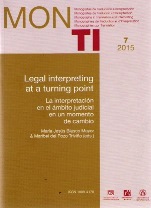Justice for All? Issues Faced by Linguistic Minorities and Border Patrol Agents during Interpreted Arraignment Interviews
##plugins.themes.bootstrap3.article.main##
Resum
Descàrregues
##plugins.themes.bootstrap3.article.details##
La propietat intel·lectual dels articles pertany als autors i els drets d'edició i publicació, a la revista. Els articles publicats en la revista podran ser utilitzats lliurement per a propòsits educatius i científics, sempre que se'n faça una correcta citació. Qualsevol ús comercial és expressament penat per la llei.
Referències
Ainsworth, Janet. (2008) “‘You have the right to remain silent...’ but only if you ask for it just so: the role of linguistic ideology in American police interrogation law.” The International Journal of Speech, Language and the Law 15:1, pp. 1-23.
Angelelli, Claudia. (2000) “Interpretation as a communicative event: A look through Hymes’ lenses.” Meta 45:4, pp. 580-592. Electronic version available at: http://erudit.org/revue/meta/2000/v45/n4/001891ar.pdf
Angelelli, Claudia. (2004) Revisiting the interpreter’s role: A study of conference, court and medical interpreters in Canada, Mexico, and in the United States. Amsterdam/Philadelphia: John Benjamins.
Berk-Seligson, Susan. (2000) “Interpreting for the police: Issues in pre-trial phases of the judicial process.” Forensic Linguistics 7:2, pp. 212-237.
Berk-Seligson, Susan. (2011) “Negotiation and communicative accommodation in bilingual police interrogations: a critical interactional sociolinguistic perspective.” International Journal of the Sociology of Language 207, pp. 29-58.
Besson, Chantal; Daria Graf; Insa Hartung; Barbara Kropfhäusser & Séverine Voisard. (2005) “The importance of non-verbal communication in professional interpretation.” International Association of Conference Interpreters. Electronic version available at: http://aiic.net/page/1662/the-importance-of-non-verbal-communication-in-professional-interpretation/lang/1
Degueldre, Christian. (2005) “Determining language proficiency levels for language professionals: issues and challenges for translators and interpreters in the United States.” Forum 3:1, pp. 67-93.
Fishman, Clifford S. (2006) “Recordings, transcripts, and translations as evidence.” Washington Law Review 81:3, pp. 437-523.
Hamel, Rainer Enrique. (1995) “Derechos lingüísticos como derechos humanos: debates y perspectivas.” Alteridades 5:10, pp. 11-23.
Hymes, Dell H. (1974) Foundations in sociolinguistics: An ethnographic approach. Philadelphia: University of Pennsylvania Press.
Kahaner, Steven M. (2009) “The administration of justice in a multilingual society - open to interpretation or lost in translation?” Judicature 92:5, pp. 224-231.
Liu, Minhua. (2004) “Working Memory and Expertise in Simultaneous Interpreting.” Interpreting 6:1, pp. 19-42.
Moser-Mercer, Barbara. (2000) “Simultaneous Interpreting: Cognitive Potential and Limitations.” Interpreting 5:2, pp. 83-94.
Ozolins, Uldis. (2001) “Telephone interpreting: Understanding practice and identifying research needs.” The International Journal for Translation & Interpreting Research 3:1, pp. 33-47.
Pavlenko, Aneta. (2008). “‘I’m very not about the law part’: Nonnative speakers of English and the Miranda warnings.” TESOL Quarterly 42:1, pp. 1-30.
Reddy, Michael J. (1979) “The Conduit Metaphor: A Case of Frame Conflict in our Language about Language.” In: Ortony, Andrew. (ed.) 1979. Metaphor and Thought. Cambridge: Cambridge University Press, pp. 284-324.
Rogers, R.; A. Correa; R. Hoersting; D. Shuman; K. Sewell; L. Hazelwood & H. Blackwood. (2008) “Spanish Translations of Miranda Warnings and the Totality of the Circumstances.” Law and Human Behavior 33, pp. 61-69.
Rosenberg, Ellen; Robbyn Seller & Yvan Leanza. (2008) “Through interpreters’ eyes: comparing roles of professional and family interpreters.” Patient Education and Counseling 80: 87-93. DOI: 10.1016/j.pec.2007.09.015
Stana, Richard M. (2007) Border Patrol: Costs and Challenges Related to Training New Agents. Testimony Before the Subcommittee on Management, Investigations, and Oversight, Committee on Homeland Security, House of Representatives. Washington: U.S. Govt. Accountability Office.
Swender, E.; D. J. Conrad & R. Vicars. (2012) ACTFL Proficiency Guidelines. Alexandria: ACTFL, Inc.
Van Dijk, Teun. (2000) “Discourse and access.” In: Phillipson, R. (ed.) 2000. Rights to language: equity, power and education. New York: Lawrence Earlbaum Associates, pp. 73-78.
Various authors (Language Testing International). (2014) Understanding Proficiency with LTI. Electronic version available at: http://www.languagetesting.com/how-long-does-it-take
Various authors (National Commission on Excellence in Education). (1983) “A Nation at Risk: The Imperative for Educational Reform.” The Elementary School Journal 84:2, pp. 112-130.
Various authors. (2013) Professional Standards and Ethics for California Court Interpreters (Fifth Edition). Electronic version available at: http://www.courts.ca.gov/documents/CIP-Ethics-Manual.pdf
Various authors (United States Census Bureau). (2010) State & county quickfacts. Electronic version available at: http://quickfacts.census.gov/qfd/states/06000.html
Various authors (U.S. Department of Homeland Security). (2014a) U.S. Border Patrol Fiscal Year 2013 Statistics. Electronic version available at: http://www.cbp.gov/xp/cgov/border_security/border_patrol/usbp_statistics/usbp_fy13_stats/
Various authors (U.S. Department of Homeland Security). (2014b) Preparation Manual for the U.S. Border Patrol Entrance Examination. Electronic versión available at: http://www.cbp.gov/linkhandler/cgov/careers/study_guides/guides_bp/entry_guide/bp_entrance_exam.ctt/prep1896.pdf
Various authors (U.S. General Services Administration). (2013) San Ysidro Land Port of Entry Fact Sheet. Electronic version available at: http://www.gsa.gov/portal/category/105703
White, R. (2006) Aqui se habla Espanol: Officers learn basics of Spanish catered to job. Electronic version available at: http://www.cbp.gov/xp/CustomsToday/2006/april/officers_learn_spanish.xml


